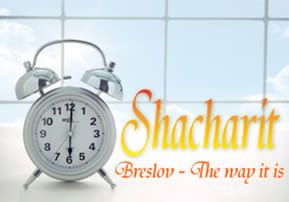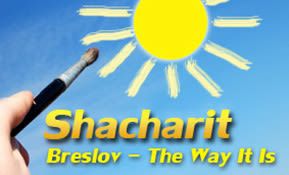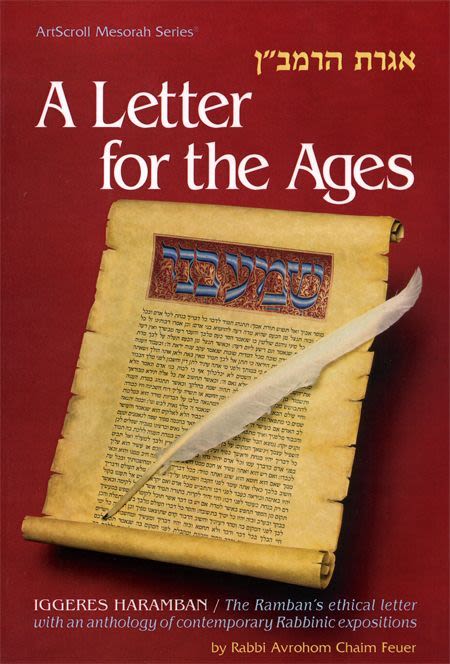
Shacharit – Part 2
According to Kitzur Likkutei Moharan I, 231: "[At this moment] one may pray for everything, for then all the angels...

Le‘ilui nishmat Leib ben Yitzchak Ya’akov Sears, a”h – Yartzeit: 30 Shevat, Rosh Chodesh Adar
Le’ilui nishmat Yosef ben Shmuel Zeitlin, a”h – Yartzeit: 18 Menachem Av
We continue with our new series of minhagim and hanhagot tovot of Breslev. We invite you to peruse our previous entries by accessing our archives.
Shacharit (continued)
Reb Gedaliah would be “meshalshel” the “Hallelukahs” in Pesukei de-Zimra. That is, he would connect the final “Hallelukah” of one psalm with the first “Hallelukah” of the next. This was the Breslever minhag in Uman (heard from Rabbi Dovid Shapiro.; see Tur, Orach Chaim 51, citing Rav Amram Gaon).
* * *
Rabbi Nachman Galant of Tzefat, a grandson of Rabbi Yochanan Berditchever, also heard that this was the Breslever minhag in the Ukraine (heard from Rabbi Hillel Lubman).
* * *
The Rebbe states that in “Vayevarekh Dovid,” when one recites the phrase “u-tzeva’ah hashomayim Lekha mishtachavim . . . The heavenly hosts prostrate themselves unto You” (Nehemiah 9:6), it is a favorable time for one to add a personal prayer. According to Kitzur Likutei Moharan I, 231: “[At this moment] one may pray for everything, for then all the angels prostrate themselves and render homage to God, may He be blessed. Therefore, it is good to entreat that Hashem command them to transmit whatever one needs. For example, if one needs healing, one should meditate that Hashem command [the angels] to invest the spiritual powers of healing into one’s bread and water, etc.” (Cf. Likutei Moharan II, 1, re. the role of the angels in the transfer of shefa’, etc.)
* * *
Reb Gedaliah would do so verbally, asking Hashem to command his angels to bring about the healing of various individuals, whose names he mentioned (heard from Rabbi Elazar Kenig and Rabbi Noach Cheifetz).
* * *
In Yishtabach, the conclusion of the berakhah is “Melekh Yachid Chei ha-‘Olamim.” This phraseology parallels that in the opening berakhah of Pesukei de-Zimra: “Barukh she-amar . . . Yachid Chei ha-‘Olamim, Melekh meshubach…” Reb Avraham Sternhartz attested that this was the Rebbe’s custom, which has been followed by Breslover Chassidim ever since. (This corresponds to the nusach in the Chabad Siddur. Since this is an unusual nusach, for which we have not yet found an earlier source, it is possible that this was something that the Rebbe and Baal ha-Tanya once discussed and agreed upon; ve-tzorekh iyyun. The Manistricher Chassidim, whose Rebbe lived in Uman, also had this nusach. However, it seems that they inherited it from Chabad, as stated by Rabbi Avraham Yehoshua Rabinowitz, ‘Ehrkei Yehoshua, Kuntres Perach Shoshanim 17.)
* * *
Rabbi Shmuel Shapiro and Rabbi Shmuel Chechik both concurred, “There is no special Breslever nusach hatefillah except to conclude ‘Yishtabach’ with the words ‘Melekh Yachid Chei ha-‘Olamim’“ (heard from Rabbi Symcha Bergman).
* * *
In Birkhat Kriat Shema’, Reb Gedaliah would say “koneihem” instead of “konam,” as mentioned by the Be’er Heitiv in the name of the ARI zal (Be’er Heitiv, Orach Chaim 59:1; similarly, see Machzor Vitry, Abudarham, Pri Eitz Chaim, Siddur Rav Shabsai Sofer).
* * *
In the kedushah de-meyushav, Reb Gedaliah would say “u-vi-ne’imah, kedushah…” with a shuruk under the letter dalet (or a vav with a melupum after the dalet). One should also pause between “u-vi-ne’imah” and “kedushah.” (This reflects the view of Rashi on Yeshaya 6:3 and Tosfot, Chagiga 13b; Rabbi Chaim Vital, Sha’ar ha-Kavannos, Inyan Nusach ha-Tefillah; Siddur ARI Rav Asher; Siddur Tefillah Yesharah−Berditchev; Siddur Heichal ha-Berakhah [Komarno]; Siddur Tefillat Yesharim−Ben Ish Chai; Darkei Chaim vi-Shalom [Munkatch], Nusach ha-Tefillah 138. Alternately, some say “kedoshah,” with a cholam under the dalet. This follows the view of Abudarham; Rabbi Yisrael Yaakov Algazi, Shalmei Tzibbur, Nusachot be-Birkhat “Yotzer,” citing Sefer ha-Kavannot be-ktav yad Rav Chaim Vital (which contradicts the standard text); Shiyarei Knesset ha-Gedolah; Sefer Hekhalot; similarly, Be’er Heitiv, Orach Chaim 59, s.k. 3; Eitz Yosef, Otzar ha-Tefillot, et al. This is also the nusach of the Siddur ha-Rav Baal ha-Tanya.)
* * *
In the paragraph that begins “La-E-l barukh,” the word “la-Melekh (E-l chai vi-kayam)” should be pronounced with a kametz under the lamed, as stated by the Be’er Heitiv in the name of the ARI zal (Be’er Heitiv, Orach Chaim 59:1; cf. Sha’ar ha-Kavannot, Yad Aharon, et al.).
* * *
Before reciting the berakhah “Yotzer ha-Me’orot,” one says “Ohr chadash ‘al Tzion ta’ir ve-nizkeh kulanu bimeheirah le-oro.” Reb Nosson explains that this is meant to awaken the soul’s deepest desire for Hashem. (See Likkutei Halakhot, Birkhat ha-Shachar 5:28. This nusach follows the view of the Zohar, Pekudei; Abudarham; Rabbi Chaim Vital, Pri Eitz Chaim, Sha’ar Ahavah, 5, et al. The Minchat Elazar redacts it in his nusach, as stated in Darkei Chaim ve-Shalom 140. However, some omit it, in keeping with the Sefardic custom; see Tur, Orach Chaim 59, citing Rashi, et al.)
* * *
According to Sha’ar ha-Kavannot, one does not add the words “ve-hiskin me-orot mesame’ach ‘olamo asher bara.”
* * *
Reb Gedaliah would begin the paragraph before Kriyat Shema with the words “Ahavat Olam” during the week, and “Ahavah Rabbah” on Shabbat, in keeping with the custom of the ARI zal. This reflects the tradition that the ARI zal prayed according to the Sefardic (i.e. Eidot ha-Mizrach) nusach during the week, and according to the Ashkenazic nusach on Shabbat and Yom Tov. Kabbalistically, Ahavah Rabbah corresponds to the World of Atzilus (Emanation) and Ahavat Olam corresponds to the World of Beriah (Creation) (Rabbi Chaim Vital, Sha’ar ha-Kavannot, Drush Kavannot “Yotzer;” Ohr Tzaddikim, 16:16; also see Eishel Avraham, Orach Chaim 60:1, who mentions this nusach. Rabbi Chaim Elazar Spira of Munkatch, Darkhei Chaim vi-Shalom, Seder vi-Nusach ha-Tefillah 141, cites it in the name of Rabbi Zvi Elimelekh of Dinov, Bnei Yissaschar, Ma’amarei Shavuot, Ma’alat he-Chag 7, hagahah. This also is said to have been the minhag of the Baal Shem Tov).
* * *
According to Sha’ar ha-Kavannot, upon saying “maheir ve-havei ‘aleinu…” one allows the talit to fall from one’s shoulders, and gathers the four tzitzit into one’s left hand, and holds them near one’s heart throughout the recitation of the three paragraphs of the “Shema.“
To be continued.
(With permission from The Breslov Center for Spirituality and Inner Growth http://www.nachalnovea.com)












Tell us what you think!
Thank you for your comment!
It will be published after approval by the Editor.